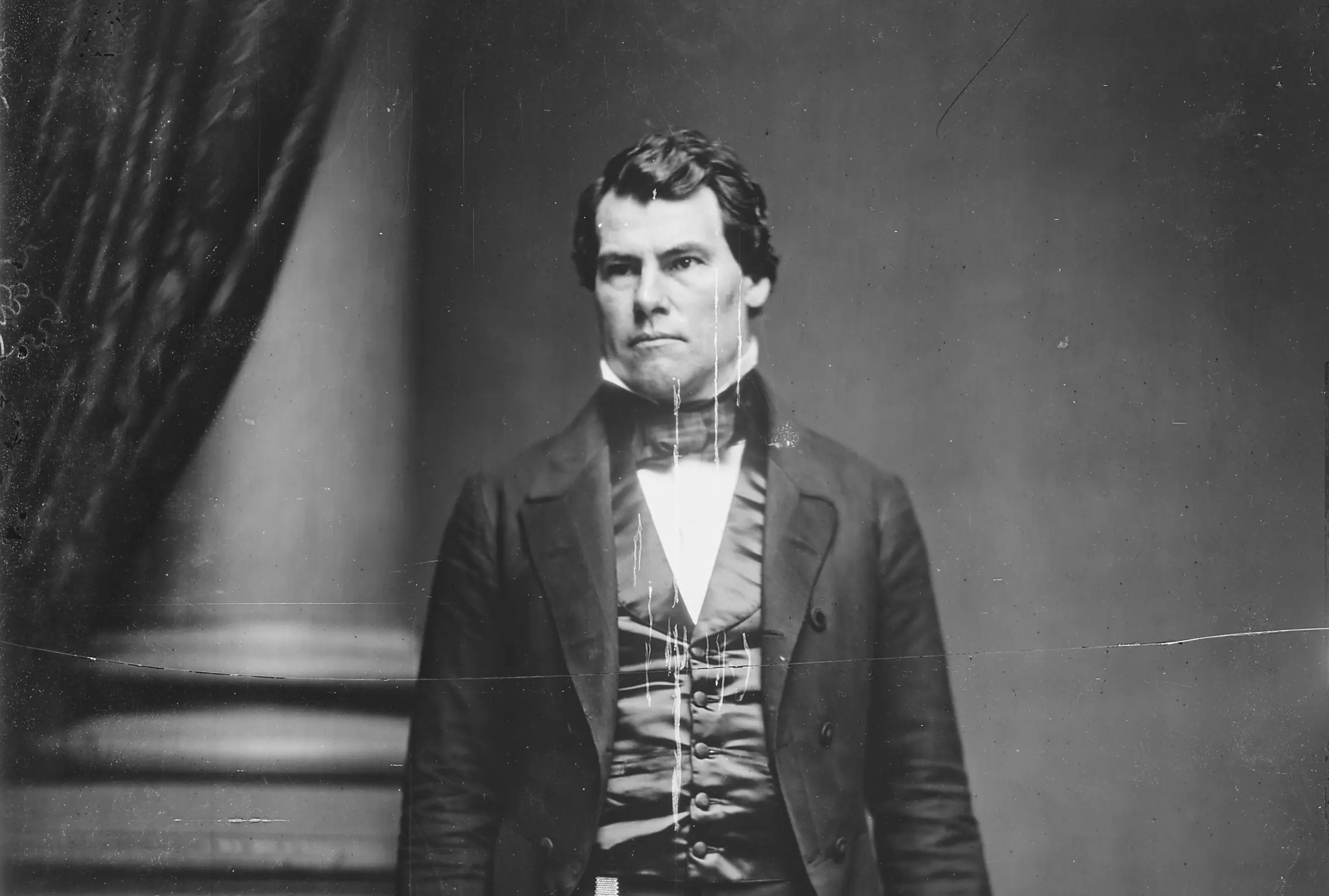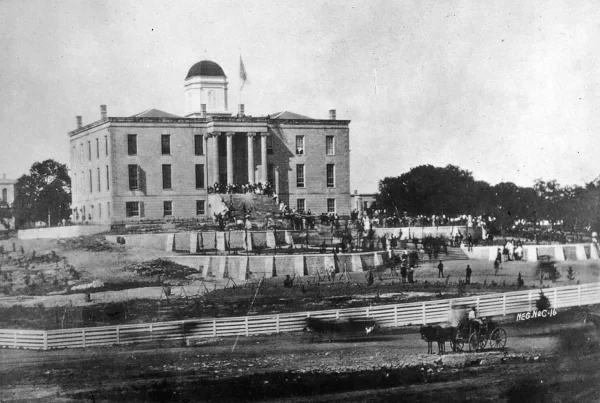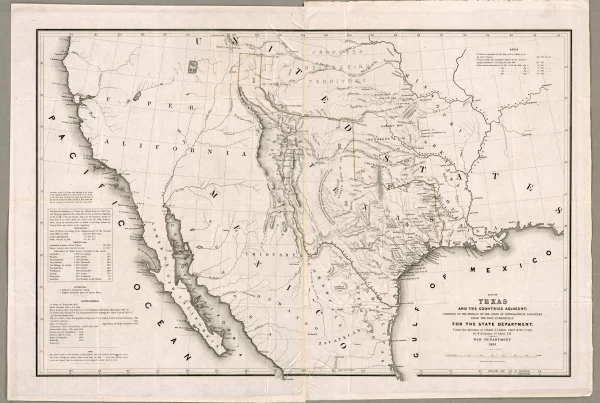John Henninger Reagan (October 8, 1818 – March 6, 1905) was a Texas lawyer, judge, and Democratic politician whose career spanned the Republic era, the Civil War, and the state’s modernization at the turn of the twentieth century. He served as Postmaster General of the Confederate States of America, represented Texas in both houses of the U.S. Congress, and became the first chairman of the Texas Railroad Commission. He was the only former Confederate cabinet member ever seated in the United States Senate.
Early Life and Education
Reagan was born on October 8, 1818, near Gatlinburg in Sevier County, Tennessee, the eldest son of Timothy Richard Reagan and Elizabeth (Lusk) Reagan. His family farmed and operated a small tannery in the Great Smoky Mountains. Reagan received limited formal schooling, attending Nancy Academy, Boyd’s Creek Academy, and later Southwestern Seminary in Maryville, which he financed through farm labor and tutoring. His mother’s death in 1831 left him responsible for younger siblings, delaying further study until 1834–37, when he again pursued education while working to support himself.
In 1838 he left Tennessee, briefly managed a plantation near Natchez, Mississippi, and the following year moved to the Republic of Texas. By July 1839 he was serving as a volunteer in the Cherokee War, taking part in the engagement near Nacogdoches in which Chief Bowl was killed. Over the next two years he worked as a deputy surveyor and frontier scout in East Texas and was elected justice of the peace and captain of a local militia company in Nacogdoches County.
Early Legal and Political Career
Reagan read law while surveying and was granted a temporary license in 1846. That same year he opened an office at Buffalo on the Trinity River and was elected the first county judge of Henderson County. In 1847 he entered the Second Texas Legislature, serving until 1849. During the session he opposed a measure involving the Peters Colony land contracts, correctly predicting that its provisions would lead to costly litigation. Though his stand contributed to his defeat for the state Senate in 1849, it later enhanced his reputation for integrity; in 1852 the Peters Colony settlers hired him as their attorney.
When the judge of the Ninth Judicial District died that September, Reagan won the special election to fill the vacancy and was re-elected in 1856. As a district judge he earned a reputation for impartiality and insistence on written law over local custom. He also became active in the Democratic Party, helping to defeat the American (“Know-Nothing”) Party in East Texas.
U.S. House of Representatives, 1857–1861
In the summer of 1857 Texas Democrats nominated Reagan for Congress, and he was elected from the First Congressional District. He served from March 4, 1857, until January 15, 1861. In Washington he represented the interests of frontier Texans while aligning with Southern Democrats on the major issues of the era. He opposed abolitionist proposals and defended the constitutional protection of slavery as private property. In 1859 he supported secessionist Hardin Runnels for governor but himself ran for Congress on a moderate, pro-Union platform; both men were elected.
During his congressional service Reagan sat on, and later chaired, the Committee on Post Offices and Post Roads, gaining administrative experience that later shaped his Confederate post.
Secession and Confederate Service
Reagan resigned from the U.S. House on January 15, 1861, after Texas voted to secede. He attended the state’s Secession Convention at Austin on January 31 and was elected one of seven Texas delegates to the provisional Confederate Congress meeting in Montgomery, Alabama. In early March 1861 President Jefferson Davis appointed him Postmaster General of the Confederate States.
Reagan organized a separate postal system when the U.S. Post Office ended service in the South on June 1, 1861. He hired many former U.S. postal clerks, abolished the franking privilege, raised rates, cut unprofitable routes, and persuaded railroads to halve their charges and accept Confederate bonds in payment. These measures enabled the department to operate efficiently despite wartime disruptions.
When Richmond fell in April 1865, Reagan accompanied Davis and other officials during their flight south. After Treasury Secretary George A. Trenholm resigned on April 27, Davis appointed Reagan Acting Secretary of the Treasury. On May 9–10, 1865, near Abbeville (sometimes cited as Irwinville), Georgia, Union cavalry captured Davis, Texas governor Francis R. Lubbock, and Reagan.
Fort Warren Imprisonment and the “Fort Warren Letter”
Reagan was confined with Confederate Vice President Alexander H. Stephens at Fort Warren in Boston Harbor. Held in solitary for twenty-two weeks, he studied Northern newspapers and concluded that reconciliation required compliance with federal authority. On August 11, 1865, he wrote an open letter to Texans urging recognition of the United States, acceptance of emancipation, and extension of voting rights to freedmen if required to avoid military rule. The letter was published in Texas in October 1865 and provoked widespread condemnation among unreconstructed Confederates.
Reagan was released in December 1865 and returned home to Palestine, Texas, where he resumed law practice and worked his farm.
Reconstruction and Return to Office
Initially ostracized for his conciliatory views, Reagan gradually regained political standing as Texans tired of Reconstruction. His letter proved prescient when federal military rule replaced provisional state governments under the Reconstruction Acts of 1867. By the early 1870s he was known as the “Old Roman,” a sobriquet likening him to Cincinnatus for his willingness to sacrifice popularity for the public good.
Reagan supported the Democratic effort to restore civilian government, which succeeded with Richard Coke’s election as governor in 1873. Granted amnesty and full citizenship, he was elected to Congress the following year.
U.S. House of Representatives, 1875–1887
Reagan served in the Forty-fourth through Forty-ninth Congresses from March 4, 1875, to March 3, 1887. He was a delegate to the 1875 Texas Constitutional Convention that drafted the present state constitution. In Washington he became one of the principal advocates of federal regulation of interstate commerce. He chaired the Committee on Commerce and earlier had led the Committee on Post Offices and Post Roads.
Reagan introduced bills in 1878 and 1884 to regulate railroad rates and practices. His proposals culminated in the Interstate Commerce Act of 1887, which created the Interstate Commerce Commission—the first permanent federal regulatory agency. The act prohibited rate discrimination and established oversight of common carriers, reflecting Reagan’s view that limited government could still prevent monopoly abuse.
U.S. Senate and the Texas Railroad Commission
Elected by the Texas Legislature in 1886, Reagan began his Senate service on March 4, 1887. He was the only former Confederate cabinet officer ever seated in the U.S. Senate. There he continued to advocate tariff reduction, currency stability, and regulation of common carriers.
On June 10, 1891, he resigned to become chairman of the newly established Texas Railroad Commission, created under Governor Jim Hogg’s administration. The commission, authorized by constitutional amendment in 1890, regulated railroad rates, classified freight, and investigated discrimination in service. Reagan led the body from its formation, serving as chairman until January 1903. His leadership helped make the commission a model for state-level economic regulation.

Reagan sought the Democratic gubernatorial nomination in 1894 but was not selected. He remained on the Railroad Commission under Governors Charles A. Culberson and Joseph D. Sayers until retiring in 1903.
Later Life, Writings, and Family
After retirement Reagan continued to write and speak on public affairs. In 1897 he helped found the Texas State Historical Association and served as one of its early officers. He attended Confederate veterans’ reunions and corresponded with historians about the Civil War and Texas politics.
He completed Memoirs, with Special Reference to Secession and the Civil War, published in 1905 by the Neale Publishing Company of New York. The volume combined personal recollection with documentary detail and remains an important firsthand account of Confederate administration.
Reagan married three times. His first wife, Martha Music, died in 1845. His second marriage, to Edwina Moss Nelms in 1852, produced six children and ended with her death in 1863. In 1866 he married Molly Ford Taylor, who bore five children, three of whom survived him.
Reagan died of pneumonia at his home in Palestine on March 6, 1905, and was buried in East Hill Cemetery. He was the last surviving member of Jefferson Davis’s cabinet.
Reagan County in West Texas, the town of Reagan in Falls County, and numerous schools and public facilities were named for him, including a legislative office building within the Texas Capitol Complex. His statue, once displayed in the U.S. Capitol’s National Statuary Hall, was moved to the University of Texas at Austin and later relocated to the Dolph Briscoe Center for American History in 2017.



